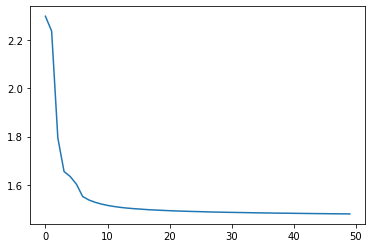
import time
import torch
import numpy as np
import torch.nn as nn
from matplotlib import pyplot as plt
import torch.nn.functional as F
from torch.utils.data import DataLoader
from torchvision import transforms
from torchvision.datasets import MNIST
transform = transforms.Compose([
transforms.ToTensor(),
transforms.Normalize((0.1307, ), (0.3081,))
])
train_set = MNIST(root = './MNIST',
train = True,
#download = True,
transform = transform)
test_set = MNIST(root = './MNIST',
train = False,
transform = transform)
train_loader = DataLoader(
train_set,
batch_size = 100,
shuffle = True
)
test_loader = DataLoader(
test_set,
batch_size = 100,
shuffle = True
)
class LeNet(nn.Module):
def __init__(self):
super(LeNet, self).__init__()
self.cal = nn.Sequential(
nn.Conv2d(1, 6, 5, 1, 2),
nn.ReLU(),
nn.MaxPool2d(2, 2),
nn.Conv2d(6, 16, 5),
nn.ReLU(),
nn.MaxPool2d(2, 2),
nn.Flatten(),
nn.Linear(5*5*16, 120),
nn.Linear(120, 84),
nn.Linear(84, 10),
nn.Softmax(dim=1)
)
def forward(self, x):
return self.cal(x)
net = LeNet()
torch.cuda.empty_cache()
net.cuda()
# net structure
LeNet(
(cal): Sequential(
(0): Conv2d(1, 6, kernel_size=(5, 5), stride=(1, 1), padding=(2, 2))
(1): ReLU()
(2): MaxPool2d(kernel_size=2, stride=2, padding=0, dilation=1, ceil_mode=False)
(3): Conv2d(6, 16, kernel_size=(5, 5), stride=(1, 1))
(4): ReLU()
(5): MaxPool2d(kernel_size=2, stride=2, padding=0, dilation=1, ceil_mode=False)
(6): Flatten(start_dim=1, end_dim=-1)
(7): Linear(in_features=400, out_features=120, bias=True)
(8): Linear(in_features=120, out_features=84, bias=True)
(9): Linear(in_features=84, out_features=10, bias=True)
(10): Softmax(dim=1)
)
)
device = torch.device('cuda' if torch.cuda.is_available() else 'cpu')
print('Using', device)
if not (device == 'cpu'):
net.to(device)
optimizer = torch.optim.SGD(net.parameters(), lr = 0.01)
loss_func = nn.CrossEntropyLoss()
egimage, eglabel = iter(train_loader).next()
plt.figure()
plt.imshow(egimage[0][0])
plt.colorbar()
plt.grid(True)
plt.show()

start_time = time.time()
epochs = 50
epoch_loss = []
for epoch in range(epochs):
running_loss = 0.0
for i, (inputs, labels) in enumerate(train_loader):
if not (device == 'cpu'):
inputs = inputs.to(device)
labels = labels.to(device)
y_hats = net(inputs)
loss = loss_func(y_hats, labels)
optimizer.zero_grad()
loss.backward()
optimizer.step()
running_loss += loss.item()
avr_loss = running_loss/(i+1)
epoch_loss.append(avr_loss)
print('epoch %d, loss: %.3f' % (epoch, avr_loss))
end_time = time.time()
print('Finished training, time used: %.3f'%(end_time - start_time))
epoch 0, loss: 2.298
epoch 5, loss: 1.603
epoch 10, loss: 1.515
epoch 15, loss: 1.500
epoch 20, loss: 1.493
epoch 25, loss: 1.489
epoch 30, loss: 1.486
epoch 35, loss: 1.484
epoch 40, loss: 1.482
epoch 45, loss: 1.481
epoch 49, loss: 1.480
Finished training, time used: 551.340
plt.plot(epoch_loss)

model_path = './MNIST_model.pkl'
torch.save(net.state_dict(), model_path)
# net.load_state_dict(torch.load(model_path))
import torch
import numpy as np
from mnist_net import LeNet
from torchvision import transforms
from torch.utils.data import DataLoader
from torchvision.datasets import MNIST
from matplotlib import pyplot as plt
transform = transforms.Compose([
transforms.ToTensor(),
transforms.Normalize((0.1307, ), (0.3081,))
])
test_set = MNIST(root='./MNIST',
train=False,
transform=transform)
test_loader = DataLoader(
test_set,
batch_size = 100,
shuffle = True
)
device = torch.device('cuda' if torch.cuda.is_available() else 'cpu')
print('Using: ',device)
net = LeNet()
# torch.cuda.empty_cache()
net.cuda()
net.load_state_dict(torch.load('./MNIST_model.pkl'))
if not (device == 'cpu'):
net.to(device)
Using: cuda
total_ac = 0
for i, (inputs, labels) in enumerate(test_loader):
if not (device == 'cpu'):
inputs = inputs.to(device)
labels = labels.to(device)
y_hats = net(inputs)
y_pred = y_hats.argmax(axis = 1)
ac = (y_pred == labels).sum()
total_ac += ac
if i==9:
break
print('Average accuracy of %d tests: %.1f'%((i+1), total_ac/(i+1)))
# output
Average accuracy of 10 tests: 98.3